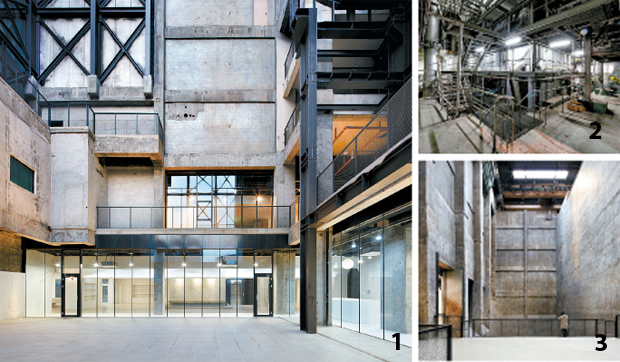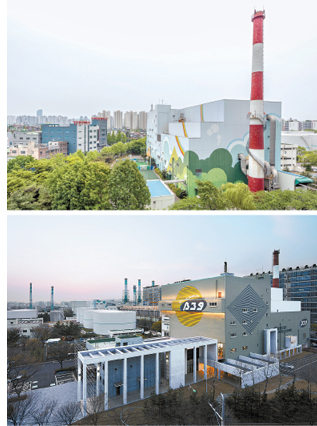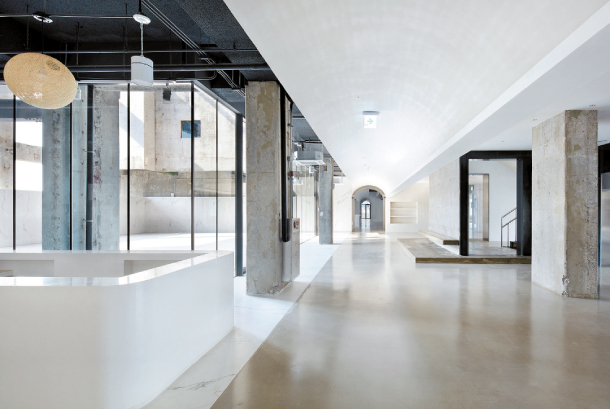Turning a trash center into a treasure

1.The room where waste was burned has become the main lobby of B39, which has been renovated into a multifunctional arts center. 2.The water treatment room before renovation. 3.The waster bunker, where waste was stored has walls that are 39 meters high. B39 plans to use this wall to present works of media art. [KIM YONG-GWAN, BUCHEON CULTURAL FOUNDATION]
The original incineration plant in Samjeong-dong with a capacity to process 200 tons of waste is 8,074 square meters (1.9 acres) large and started running in 1995. With the city of Bucheon expanding, the plant, which was originally built on the outskirts of the city, now stands within a bustling urban center. The city decided to make a new plant farther out and the one in Samjeong-dong ceased operations. The plant that ran for 15 years could have been destroyed altogether but Bucheon decided to instead renovate the space.
It recruited architects and studio_K_works was chosen for its proposal that would leave some of the older facilities for educational and cultural purposes.
“We selected what to leave and what to remove in order to have visitors see how waste was processed before,” said architect Kim Kwang-soo. “The main concept was to add as little as possible architecturally.”

At top, the Bucheon incineration plant before the renovation, and above is the renovated B39. A new corridor has been added in the building so that people can easily see what’s inside while passing through. [BUCHEON CULTURAL FOUNDATION, KIM YONG-GWAN]
The inside of the plant originally was categorized into six different areas: the room where waste was put into the plant, a bunker, the area where the waste was burned, another bunker to collect the remnants, a waste water processing unit and an exhaust gas processing unit. Some were removed, such as a burning area and waste water processing unit, to make space. The room that once held waste was renovated as a multimedia hall.
The bunker where all the waste was stored before being incinerated is about 39 meters (127 feet) high, which is about as high as a 15-story apartment building. Since the volume of the space shows how large the plant was and how much waste it processed, the number was used to name the building, B39. The 39-meter-high wall will be the background for media art. The incineration plant has a total of five stories, but only the first two stories have been renovated. The operation team will run the space for now and gather more funds for more renovations.
How was it possible to have the building reopen as something else eight years after it closed its doors? The Bucheon city government and Bucheon Cultural Foundation have continued to talk about how to make a better use of the closed facility. The city and the foundation applied to work on a project issued by the Ministry of Culture, Sports and Tourism in 2014 regarding how to culturally renovate standing industrial complexes, and they decided to renovate the facilities they already have. The national government and the city government worked together to come up with a budget of 9.5 billion won ($8.9 million). According to Son Gyeong-nyeon, the president of Bucheon Cultural Foundation, the cost to just demolish the plant could have reached up to 7 billion won.

An area once used to store remnants left over after burning waste has become a lobby to a cafe and restaurant after renovation. [KIM YONG-GWAN]
After they decided to keep the building, they used about half of the four years they had to plan out what to do and conduct research. Son and executive architect U Ui-jeong, alongside 12 consultants with backgrounds in architecture, design, cultural planning, policy making and social activities made up the foundation. They focused on the goal of the project so that no outside forces could intervene. Even when the construction was delayed longer than planned due to reinforcing the structure of the original facility, the consultants wrote a letter of evaluation to persuade the central government, which was rushing the city to complete the project as soon as possible.
Instead of renovating the building first and then decided what to do with it, the question of what to fill the renovated space with was being considered from the beginning of the project. Social venture Noridan was chosen even before the city recruited architects so that Noridan and the architects could work together from the beginning to design the space.
About 14 percent of the total budget was set aside in the beginning to come up with cultural content, and 16 pilot programs testing out ideas were held the year before actual renovations started. The pilot programs were about exploring the meaning of the original plant and how it can make harmony with any future content they want to put in. Local citizens and artists participated as well.
Project organizers also spent enough time hiring architects as well. It hired the executive architect U Ui-jeong and encouraged young and talented architects to join. U said the recruiting process simplified the application documents and lowered the number of prerequisites applicants needed so that applicants could focus more on showing their ideas. Judges in the recruiting process held a discussion with one another to select who to hire instead of giving scores to each and every applicant and choosing the ones with the highest scores. The judges discussed the candidates until they reached a unanimous decision.
“It was a rare case of public and private forces collaborating together instead of the public sector unilaterally leading the renovation project,” said researcher Jo Gwang-ho of the Korea Culture and Tourism Institute.
BY HAN EUN-HWA [summerlee@joongang.co.kr]
[한은화의 A- story] 부천 가동중단 쓰레기 소각장
애초부터 환영받지 못한 존재였다. 경기도 부천 삼정동 소각장은 중동 신도시가 들어서면서 함께 태어났다. 하루 200t의 쓰레기를 처리할 수 있는 규모(연면적 8074.79㎡)로 1995년 가동을 시작한 이래, 소각장은 지역의 골칫덩어리였다. 97년 다이옥신 파동이 결정적이었다. 당시 환경부 발표에 따르면 삼정동 소각장은 기준치의 20배가 넘는 다이옥신(㎥당 23.12㎎)을 뿜어내고 있었다. 시설 재정비 후 소각장은 다시 가동됐지만, 도시가 쑥쑥 자라면서 외곽에 있던 소각장은 어느새 시가지 안에 자리 잡게 됐다. 부천시는 새로운 소각장을 지었고, 삼정동 소각장은 2010년 가동이 중단됐다.
15년 반목의 역사였다. 그냥 부수고 밀어버리면 끝날 이야기였다. 그런데 소각장은 8년 만에 다시 문을 열었다. 복합문화예술 공간으로 재단장했다. 영국 런던 테이트모던 미술관처럼 발전소를 미술관으로 바꾼 사례는 있지만, 쓰레기 소각장의 재생 사례는 세계 최초다. 이제 쓰레기 소각장이 아니라 ‘부천아트벙커 B39’(이하 B39)로 거듭난 공간은 13일 개관식을 했고, 공식 오픈(6월 1일)을 앞두고 있다. 부천의 대표 혐오시설은 어떻게 문화공간이 됐을까. 주민, 지자체, 중앙 정부, 건축·예술·행정 전문가의 설전(舌戰)이 4년간 지속한 끝에 나온 결과였다. 전국 지자체마다 ‘재생’ 이슈가 넘쳐나는 요즘, 주목해야 할 ‘느린 재생’ 이야기이기도 하다.
쓰레기 소각장 재생 사례는 세계 처음
B39의 리노베이션은 설계 공모전에서 당선된 건축가 김광수(studio_K_works 대표·커튼홀 공동대표)가 맡았다. 모두 새로 바꾸는 것이 아니라, 소각장의 흔적은 남기면서 문화 생산기지이자 교육 공간으로서의 기능을 새로 담는 데 집중했다. 김 대표는 “쓰레기 소각 과정을 B39에서도 체험할 수 있게, 기존 시설을 꼼꼼히 들여다 보며 남길 것과 철거할 것을 구분했다”며 “건축적으로 최소한으로 개입한다는 게 메인 콘셉트였다”고 덧붙였다. 부족한 예산 문제를 극복하기 위한 전략이기도 했다. 프로젝트의 총괄 건축가였던 우의정 건축가(메타 건축사사무소 대표)는 “공모전 응모안 중 외관을 완전히 바꾸는 것도 있었지만, 옛것과 새것의 모습이 대비되며 서로 대화하는 김광수 건축가의 안이 높이 평가됐다”고 전했다.
지난 5일 김 대표와 B39를 둘러봤다. 외관상으로 크게 달라진 점은 없었다. 페인트 칠을 새로 했고, 건물 동쪽에 긴 통로가 생긴 정도였다. 그런데 이 통로가 B39의 핵심 장치였다. 입구부터 건물 끝까지 관통하는 통로를 건물 내부에서 걷다 보면, 옛 소각장과 새 문화 공간을 함께 만나게 된다.
원래 소각장 내부는 소각 과정에 따라 필요한 6개의 실이 일렬로 나열돼 있었다. 쓰레기 반입실-벙커-소각조-재벙커-폐수 처리실-배기가스 처리장 순이었다. 반입실과 벙커는 쓰레기의 공간이었고, 소각조부터는 쓰레기를 태우고 뒤처리하기 위한 설비들이 쭉 연결돼 있었다. 이른바 기계들의 공간이었다. 건축가는 6개의 실 중 소각조와 폐수 처리실 등의 설비를 철거하고 새 공간을 만들었다. 소각장의 반입실은 멀티미디어홀로 재단장했다.
새것과 옛것이 중첩된 모습은 기이했다. 인간의 공간이 아니었던 쓰레기 소각장은 공간 규모 자체가 달랐다. 쓰레기 벙커만 해도 높이가 39m에 달한다. 15층 아파트 높이다. B39의 숫자는 바로 벙커의 높이다. 벙커 안에 새로 놓인 통로에서 그 공간감을 체험할 수 있다. 39m의 콘크리트 벽은 이제 미디어 아트의 무대가 될 예정이다. 쓰레기로 가득했던 공간에 달이 뜨고, 꽃도 피어날 터다.
소각장은 총 5층이지만, 1~2층만 재단장했다. B39의 운영을 맡은 사회적 기업 노리단의 류효봉 대표는 “일단 사용해 보면서 예산을 확보해 필요한 공간으로 차차 바꿔나갈 계획”이라며 “그게 진짜 재생”이라고 덧붙였다. 사실 공공 프로젝트의 경우 사업 계획을 수립해 예산을 책정받고 실행하고 해당 연도 안에 사업을 끝내는 과정에서 늘 일정에 쫓기게 마련이다. 그런데 B39는 어떻게 천천히 바뀔 수 있었을까.
빨리빨리보다 뜸들이기, 시민과 함께하기
소각장이 폐쇄된 후 지역 사회에서는 활용 방안을 놓고 꾸준한 논의가 이어졌다. 부천시와 부천문화재단이 2014년 문화체육관광부의 ‘산업단지 및 폐산업시설 문화재생사업’에 공모해 뽑히면서 부수고 새 건물을 짓지 말고, 기존 시설을 재단장하기로 전략을 세웠다. 중앙 정부와 지자체가 1대 1로 매칭해 마련한 예산은 95억원. 손경년 부천 문화재단 대표는 “소각장을 철거할 경우 드는 비용이 고철 값을 제외하고도 70억원에 달했다”며 “꼭 재생해야 할 만큼 소각장 건물이 지닌 가치가 크지 않더라도 도시의 역사, 소각장 문제로 환경운동가가 된 시민들의 역사를 담고 있는 만큼 재단장해 새로 써보자고 의기투합했다”고 덧붙였다.
재생으로 방향을 굳힌 후 다시 문 열기까지 걸린 4년의 시간 중 절반을 계획을 짜고 연구하는 데 썼다. 건축·디자인·문화기획·정책연구·활동가 등 12명으로 구성된 민간 자문단과 총괄 기획자(손경년 부천문화재단 대표), 총괄 건축가(우의정 건축가)가 밑그림을 그려 나갔다. 이들은 프로젝트의 방향성과 틀부터 단단히 잡아 외부 변화에 휘둘리지 않게 하는 데 주력했다. 기존 시설의 구조 보강 문제로 예상치 못하게 공사 기간이 늘어날 때도 자문단이 써준 관련 평가서를 내세워 빨리 사업을 끝내라는 중앙 정부를 설득할 수 있었다.
콘텐트는 프로젝트 시작 단계부터 함께 논의됐다. 공사 끝내고 콘텐트를 고민하는 게 아니라, 건축가 공모전에 앞서 공간 운영자부터 선정했다. 그렇게 뽑힌 사회적 기업 노리단은 처음부터 건축가와 협의해 필요한 공간을 디자인해 나갔다. 또 콘텐트 개발비를 따로 배정해(전체 예산의 14%) 리노베이션 전, 1여 년간 16개의 파일럿 프로그램을 진행했다. 소각장의 의미를 탐색하고, 앞으로 어떻게 쓸지 탐구하는 프로그램들이었다. 이 프로그램에 시민과 지역 예술가 등이 참여하면서 복합문화공간으로서 B39의 가능성이 구체화되기 시작했다. 공사는 끝났으나 콘텐트가 부실해 운영에 차질을 빚는 여타 다른 재생 프로젝트와 확연히 다른 지점이다.
리노베이션을 맡을 건축가를 뽑는 데도 공을 들였다. 공모전에 앞서 총괄 건축가(우의정)를 임명하고, 젊고 유능한 건축가들이 많이 참여할 수 있도록 공정한 판을 짜게 했다. 우 대표는 “공모전 제출 서류의 문턱을 확 낮춰 돈 들어가는 표현 방식은 제한하고 아이디어에 집중할 수 있게 했다. 심사위원도 평가할 때 점수를 매기는 대신 끝장 토론을 벌여 전원합의 형태로 건축가를 뽑았다”고 전했다. 자문단에서 정책 자문을 맡은 한국문화관광연구원의 조광호 연구원은 “공공이 일방적으로 재생 프로젝트를 끌고 가는 게 아니라, 민·관의 협력 체계를 갖춰 재생한 드문 사례”라고 의미를 부여했다.
15년간 닫혔던 소각장은 이제 B39라는 새 이름으로 활짝 열렸다. 선보이고, 키워나갈 콘텐트가 넉넉히 쌓인 채다. 앞으로 삼정동 소각장은 쓰레기 대신 무엇이든 담을 수 있는 상상력 가득한 공간으로 자라날 일만 남았다.
한은화 기자










with the Korea JoongAng Daily
To write comments, please log in to one of the accounts.
Standards Board Policy (0/250자)